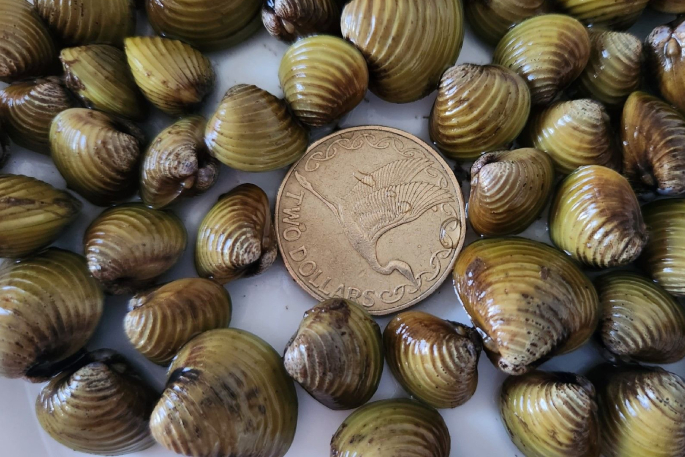More than $10 million has been put towards eradicating the invasive freshwater gold clam discovered in New Zealand waters last year.
The freshwater gold clam, or Corbicula fluminea, was found in the Waikato River in May last year and multiplied to cover a 200km stretch, from Lake Maraetai Landing to Tuakau.
They were also discovered at the Lake Taupō Aqua Park earlier this year.
Current interventions have included closing off several lakes, including Rotorua’s Lake Okataina, and rivers in the Waikato, as well as the installation of mandatory QR codes and permanent washing stations.
National Institute of Water and Atmospheric Research (Niwa) said today it had been awarded $10.2m by the Ministry of Business, Innovation and Employment (MBIE) to eradicate the clam native to eastern and southeast Asia.
Niwa principal scientist freshwater ecology Deborah Hofstra said without intervention, large-scale invasion of corbicula could result in significant and irreversible economic, social, cultural and ecosystem losses.
“This species breeds rapidly and densely, with tens of thousands of individuals occupying a single square metre.
“This means they successfully compete against native species for food and space, whilst also clogging up critical infrastructure such as water treatment plants.
“Because it’s only recently been discovered here, we lack a detailed understanding of how this species will respond in New Zealand conditions; how readily they will spread, how severe the impacts will be, and what the most effective ways are to intervene.”
Hofstra said the best chance to stop further spread of corbicula is by acting early.
“We were delighted to get this funding because the effects of these clams could be devastating, so we must move quickly; it is now or never.”
Corbicula are found globally, having become an invasive species throughout Europe, South and North America.
They can tolerate a range of habitats, and because they multiply extensively and their larvae move freely through water they can easily be transported between connected waterways or by human activities, for example as unwanted ‘hitchhikers’ on boats or recreational gear that has been in the water.
Check, clean and dry
Before moving between waterways you must do the following for all gear that comes into contact with water:
Check
Remove any plant matter and leave it at the site (the river or lake bank), or put it in the rubbish. Don’t wash it down any drain.
Clean
Dishwashing detergent is not effective against gold clams, but hot water is.
For absorbent material, such as lifejackets or clothing, wash with hot water above 60C for at least 1 minute; between 50-54C (hot household tap water) for at least 5 minutes; or above 45C for at least 20 minutes. Alternatively, soak items in a 10 per cent bleach solution.
Dry
Ensure gear is completely dry to touch, inside and out, then leave to dry for at least another 48 hours before using it.
Source: mpi.govt.nz



0 comments
Leave a Comment
You must be logged in to make a comment.